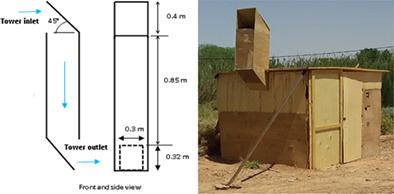当前位置:
X-MOL 学术
›
Int. J. Energy Res.
›
论文详情
Our official English website, www.x-mol.net, welcomes your
feedback! (Note: you will need to create a separate account there.)
New passive thermal comfort system using three renewable energies: Wind catcher, solar chimney and earth to air heat exchanger integrated to real‐scale test room in arid region (Experimental study)
International Journal of Energy Research ( IF 4.3 ) Pub Date : 2020-09-15 , DOI: 10.1002/er.5911 Nasreddine Sakhri 1 , Abdeljabar Moussaoui 1 , Younes Menni 2 , Milad Sadeghzadeh 3 , Mohammad Hosein Ahmadi 4
International Journal of Energy Research ( IF 4.3 ) Pub Date : 2020-09-15 , DOI: 10.1002/er.5911 Nasreddine Sakhri 1 , Abdeljabar Moussaoui 1 , Younes Menni 2 , Milad Sadeghzadeh 3 , Mohammad Hosein Ahmadi 4
Affiliation

|
Thermal comfort is one of the ancient‐new challenges of the arid region population and responsible for more than 40% of energy end‐use. Renewable energy can be a solution to this problem. In the present paper, the potential of renewable energies to ameliorate thermal comfort and reducing energy consumption in building sectors is experimentally investigated. Three renewable‐based applications are used: wind‐catcher (WC), solar chimney (SC), and earth to air heat exchanger (EAHE). The three techniques are connected to a real‐scale test room and investigated using in‐situ measurement. The contribution of each technique is discussed separately. Temperature, humidity sensors, and anemometer are used to study parameters affecting thermal comfort. Obtained results show that the use of wind‐catcher could provide in the presence of wind an internal airflow of 3.8 m.s−1 which reduces inside room temperature by 6°C. A solar chimney creates a difference between its inlet and outlet air temperature by 5.9°C and increases the kinetic energy of hot air leaving the solar chimney which is replaced by cool air from outside and other devices outlet (EAHE and WC) and increases internal airflow even with the absence of winds. The earth to air heat exchanger increases the outlet air temperature in winter by 8°C and reduces it by 12°C in summer. Inside test room hygrometry is also ameliorated by the use of EAHE. Analyzing the new system (test room + WC + SC + EAHE) shows an important amelioration of inside thermal comfort. A difference between inside and outside test room temperature is found: reduction of 13°C in summer, and a gain of 10°C in winter. The new system leads to better inside test room thermal comfort conditions and to reduce energy consumption by almost 50%. The present study presents the first experimental investigation of using three renewable energies in the same building to improve thermal comfort. Using real scale room and in‐situ measurement gives a realistic idea and results show that green energy could improve the thermal situation and energy saving. This is an original work to motivate building designers, especially in the arid region to use more than one renewable energy to ameliorate thermal comfort in both summer and winter seasons.
中文翻译:

使用三种可再生能源的新型被动式热舒适系统:集风器,太阳能烟囱和地对空热交换器,已集成到干旱地区的真实规模测试室中(实验研究)
热舒适性是干旱地区人口的古老挑战之一,占能源最终用途的40%以上。可再生能源可以解决这个问题。在本文中,通过实验研究了可再生能源改善建筑行业的热舒适性并减少能耗的潜力。使用了三种基于可再生能源的应用:捕风器(WC),太阳能烟囱(SC)和地热热交换器(EAHE)。这三种技术都连接到实际测试室,并使用现场测量进行了研究。每种技术的贡献将单独讨论。温度,湿度传感器和风速计用于研究影响热舒适度的参数。-1可将室内温度降低6°C。太阳烟囱在进风口和出风口温度之间产生5.9°C的差异,并增加离开太阳烟囱的热空气的动能,该热能被来自外部和其他设备出口(EAHE和WC)的冷空气取代,并增加内部气流即使没有风 地对空气热交换器在冬天将出口空气温度提高8°C,在夏天将其降低12°C。通过使用EAHE,还可以改善测试室内的湿度。分析新系统(测试室+ WC + SC + EAHE)显示出内部热舒适性的重要改善。测试室内外温度之间存在差异:夏季降低13°C,冬季降低10°C。新系统可带来更好的内部测试室热舒适度,并将能耗降低近50%。本研究提出了在同一建筑物中使用三种可再生能源改善热舒适性的首次实验研究。使用实际规模的房间和现场测量给出了一个现实的想法,结果表明绿色能源可以改善热状况并节省能源。这是一项原始工作,旨在激励建筑设计师,特别是在干旱地区,在夏季和冬季,使用不止一种可再生能源来改善热舒适性。使用实际规模的房间和现场测量给出了一个现实的想法,结果表明绿色能源可以改善热状况并节省能源。这是一项原始工作,旨在激励建筑设计师,特别是在干旱地区,在夏季和冬季,使用不止一种可再生能源来改善热舒适性。使用真实比例的房间和现场测量给出了一个现实的想法,结果表明绿色能源可以改善热状况并节省能源。这是一项原始工作,旨在激励建筑设计师,特别是在干旱地区,在夏季和冬季,使用不止一种可再生能源来改善热舒适性。
更新日期:2020-09-15
中文翻译:

使用三种可再生能源的新型被动式热舒适系统:集风器,太阳能烟囱和地对空热交换器,已集成到干旱地区的真实规模测试室中(实验研究)
热舒适性是干旱地区人口的古老挑战之一,占能源最终用途的40%以上。可再生能源可以解决这个问题。在本文中,通过实验研究了可再生能源改善建筑行业的热舒适性并减少能耗的潜力。使用了三种基于可再生能源的应用:捕风器(WC),太阳能烟囱(SC)和地热热交换器(EAHE)。这三种技术都连接到实际测试室,并使用现场测量进行了研究。每种技术的贡献将单独讨论。温度,湿度传感器和风速计用于研究影响热舒适度的参数。-1可将室内温度降低6°C。太阳烟囱在进风口和出风口温度之间产生5.9°C的差异,并增加离开太阳烟囱的热空气的动能,该热能被来自外部和其他设备出口(EAHE和WC)的冷空气取代,并增加内部气流即使没有风 地对空气热交换器在冬天将出口空气温度提高8°C,在夏天将其降低12°C。通过使用EAHE,还可以改善测试室内的湿度。分析新系统(测试室+ WC + SC + EAHE)显示出内部热舒适性的重要改善。测试室内外温度之间存在差异:夏季降低13°C,冬季降低10°C。新系统可带来更好的内部测试室热舒适度,并将能耗降低近50%。本研究提出了在同一建筑物中使用三种可再生能源改善热舒适性的首次实验研究。使用实际规模的房间和现场测量给出了一个现实的想法,结果表明绿色能源可以改善热状况并节省能源。这是一项原始工作,旨在激励建筑设计师,特别是在干旱地区,在夏季和冬季,使用不止一种可再生能源来改善热舒适性。使用实际规模的房间和现场测量给出了一个现实的想法,结果表明绿色能源可以改善热状况并节省能源。这是一项原始工作,旨在激励建筑设计师,特别是在干旱地区,在夏季和冬季,使用不止一种可再生能源来改善热舒适性。使用真实比例的房间和现场测量给出了一个现实的想法,结果表明绿色能源可以改善热状况并节省能源。这是一项原始工作,旨在激励建筑设计师,特别是在干旱地区,在夏季和冬季,使用不止一种可再生能源来改善热舒适性。











































 京公网安备 11010802027423号
京公网安备 11010802027423号